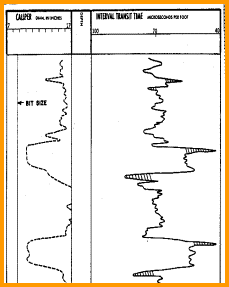 |
| What a sonic log looks like... |
We'll start this out by explaining what sonic logging isn't: sonic logging has nothing to do with seismic waves, nor does it have anything to do with two- or three-dimensional areas. Sonic logs are used by the petroleum industry to estimate the porosity and density of the rocks penetrated by a borehole (what laymen call a "well"). Reed got some of that right, but got more of it wrong. Here's what he says:
"The transmitter sends sound pulses in short bursts, which enter the rock surrounding the borehole; some of the sound reflects quickly back to the receiver, and some enters the surrounding rock and is diffracted, which means it changes direction from the outgoing sound. As the diffracted sound returns to the receiver, the time difference between the transmitted and returning sound is recorded."That whole "diffraction" bit? it has nothing to do with sonic logs; Paul's conflating sonic logging with seismic exploration. Reed's next tangent?
"The second type of sound waves to return to the receiver is S-waves, or shear."Here, Paul conflates sonic logging with seismology. Yes, there are shear-wave tools, but they are not sonic logs! Finally, Reed wanders off in the direction of, "Why use sonic logs in the first place?"
"Sonic logging is effective for determining the characteristics of a borehole because sound travels differently depending on the rock or soil surrounding the transmitter. The first sounds to return to the receiver are p-waves, or pressure waves, because they typically have the highest velocity, or speed. P-waves will travel faster in higher density rock, and slower in less dense sand or soil, which is called more porous."His bushwa about "less dense sand or soil" notwithstanding, this is the closest Reed gets to what sonic logging is. What he completely missed while performing a copy-reword-paste job of some other, far more authoritative, source (WiseGeek doesn't publish references) is a couple of things: |
- Sonic logging simply measures transit time (ΔT) over a known distance, from source to receiver
- The more dense the rock in the interval, the faster that transit time
- "Density" combines the bulk density of the rock with the density of the fluids in the pore space. If we know what fluids are filling the pores and the bulk density of the rock, it is mathematically simple to derive an estimate of porosity.
copyright © 2018-2023 scmrak
SI - OIL

No comments:
Post a Comment